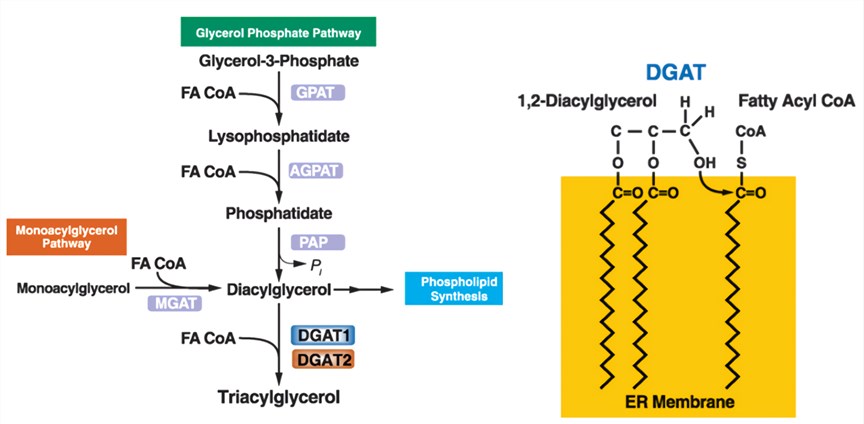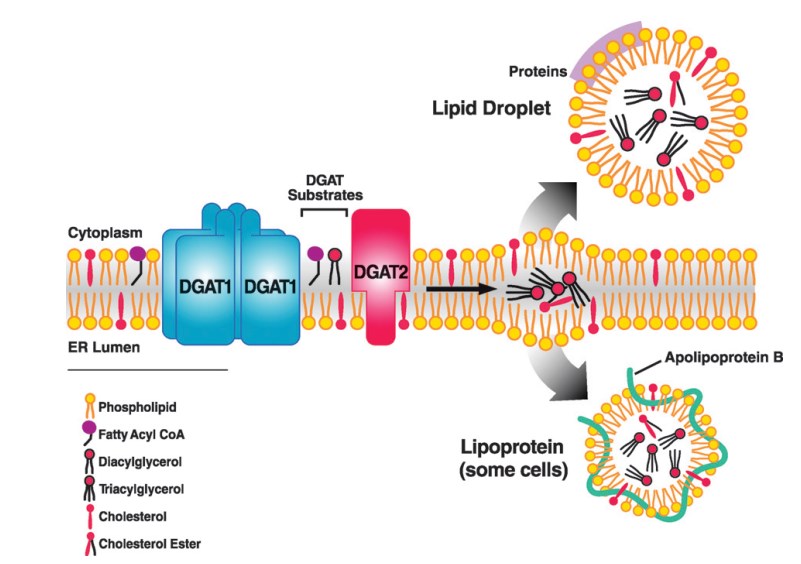NASH Target Development Service for DAG O-Acyltransferase (DGAT) Inhibitors
Creative Biolabs is capable of providing global customers with a diversiform portfolio of NASH treatment services based on our years of experience and high-end technologies in target identification for drug discovery.
What is DAG O-Acyltransferase?
As is known to all, triacylglycerols (TGs) are a class of esters of glycerol and fatty acids. They are critical major energy-storage molecules in almost all eukaryotic organisms and play significant roles in mammalian energy metabolism and homeostasis. The imbalance between energy intake and consumption may result in accumulation of TGs in tissues and thereby lead to many pathological reactions. Exactly, diglyceride acyltransferase O-acyltransferase (DGAT) is the enzyme that catalyzes the formation of TGs. TGs biosynthesis generally is achieved by phosphoglycerin pathway and monoacylglycerol pathway. DGAT catalyzes TGs production from diacylglycerol and fatty acyl-CoA in the terminal and only committed step of those two pathways. DGAT has two isoforms: DGAT1 is mainly expressed human small intestine, adipose tissue, mammary gland, etc.; and DGAT2 primarily exists in the liver and adipose tissue.
 Fig.1 Triacylglycerol synthesis and acyl-CoA: diacylglycerol acyltransferase (DGAT) enzymes. (Eric Yen, 2008)
Fig.1 Triacylglycerol synthesis and acyl-CoA: diacylglycerol acyltransferase (DGAT) enzymes. (Eric Yen, 2008)
DAG O-Acyltransferase (DGAT) Inhibitors for NASH Treatment
TGs are essential substances for normal processes and physiologies but the excessive accumulation of them in human tissues can lead to various disorders. Nonalcoholic fatty liver disease, especially nonalcoholic steatohepatitis (NASH), will be caused by excessive TGs deposition in the liver. In human, both DGAT1 and DGAT2 are expressed in the liver. Researches demonstrated that either DGAT1 or DGAT2 overexpression (DGAT2 dominates) is remarkably associated with adiposity, insulin resistance, and NASH. Selective knockout of DGAT1/DGAT2 in vitro or DGAT inhibition with antisense oligonucleotides or other inhibitors can protect mice against fatty liver by decreasing hepatic TGs biosynthesis.
Therefore, DGAT inhibitors are potential therapies for NASH treatment. A DGAT1 inhibitor called Pradigastat is an approved pharmacological molecule for familial chylomicronaemia syndrome treatment, which also presented NASH therapeutic effects in a clinical trial recently. Several DGAT2 inhibitors have been developed for the treatment of NASH, such as niacin (also named vitamin B3), mangiferin, indolyl acrylamide derivatives, and pyrrolopyridine derivatives and so forth. Creative Biolabs provides comprehensive services for NASH treatment research, including the development of DGAT inhibitors.
 Fig.2 Hypothetical model illustrating the role of DGAT enzymes in triacylglycerol synthesis in the endoplasmic reticulum. (Eric Yen, 2008)
Fig.2 Hypothetical model illustrating the role of DGAT enzymes in triacylglycerol synthesis in the endoplasmic reticulum. (Eric Yen, 2008)
As a biological company dedicated to human health research, much work has been done in Creative Biolabs to find a better therapy or pharmaceutical candidate for NASH. In addition to DGAT, we discover many other potential and useful targets for NASH treatment. Moreover, we also offer other all-around NASH treatment services based on our advanced platforms (e.g. Hit to Lead, Lead Optimization, IND-Enabling, Target Identification, and Validation, Hit identification). Our NASH treatment services include but not limited to:
- Biomarkers for NASH Diagnosis
- Target Discovery and Therapeutic Strategies
- Preclinical Models of NASH
You can directly contact us and communicate your specific demands with us for more information. We believe that our high-quality services and professional teams must offer you satisfactory strategies.
Reference
- Eric Yen, C.L.; et al. DGAT enzymes and triacylglycerol biosynthesis. Journal of Lipid Research. 2008, 49(11): 2283-2301.
 For Research Use Only.
For Research Use Only.